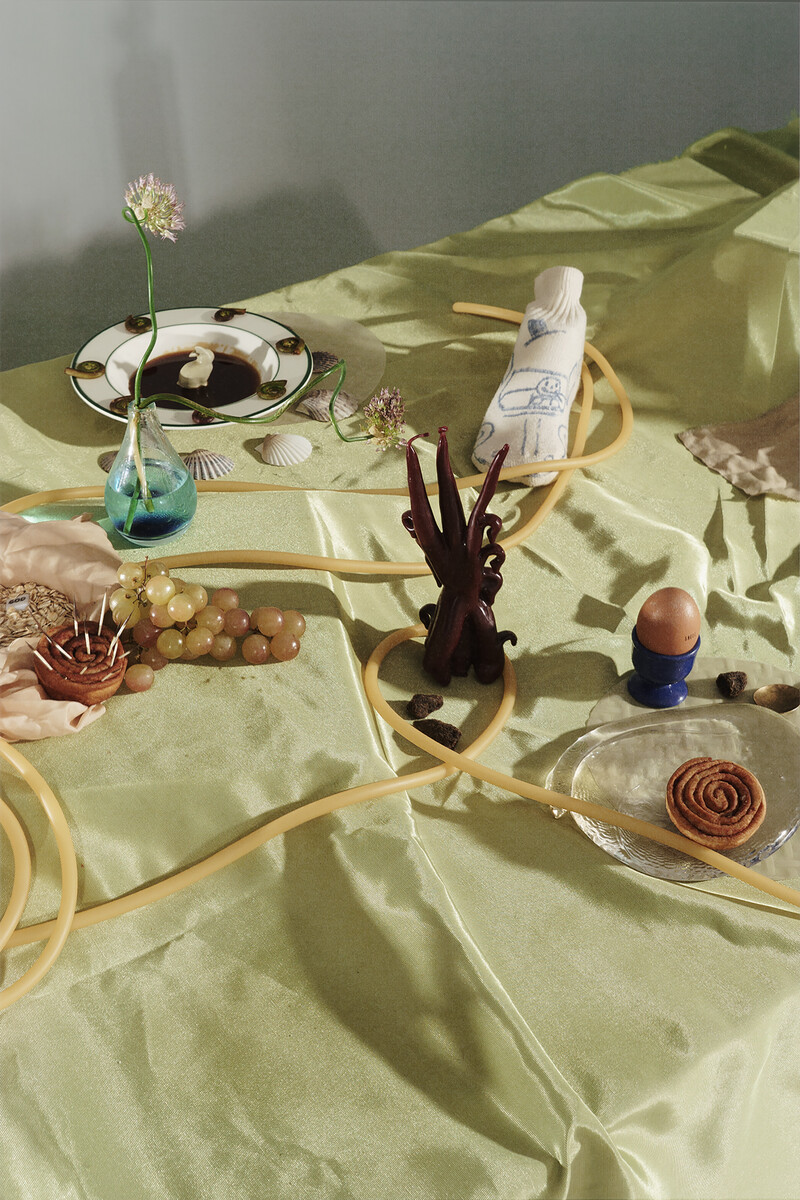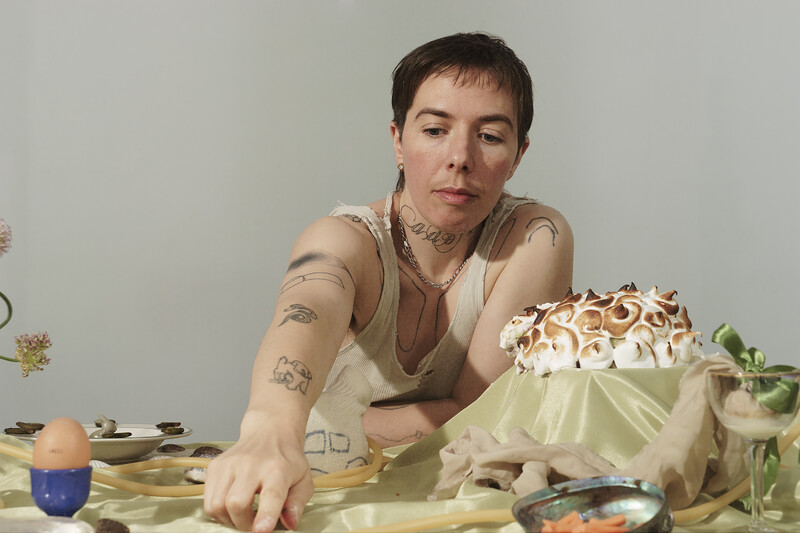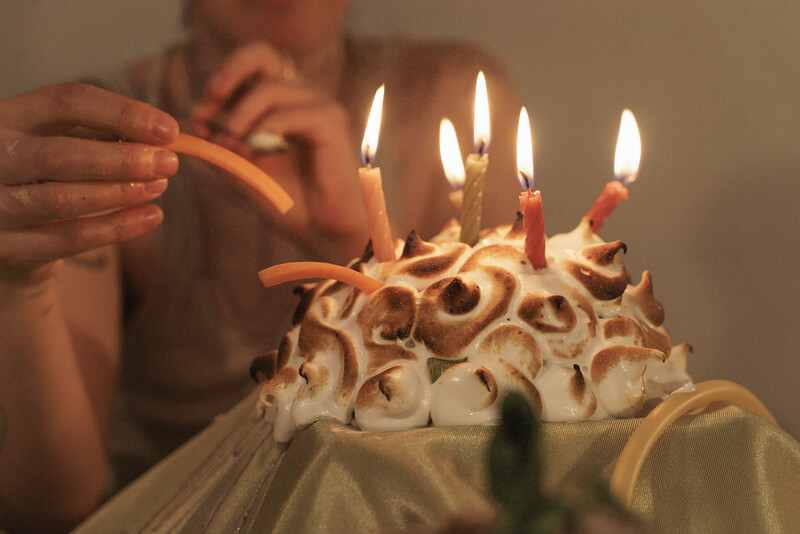- 15.0Cover
- 15.1How to Read this Broadsheet
- 15.2Variations on IdiorrhythmyHeather Kai Smith
- 15.3Thresholds of ResistanceIlya Vidrin
- 15.4The Archive and UsVania Gonzalvez Rodriguez, mother tongues
- 15.5Coral VisionJess Watkin
- 15.6Casting Our Kino-Eyes Over the Collective HorizonThe Post Film Collective
- 15.7KOMQWEJWI'KASIKL 2Michelle Sylliboy
- 15.8Animating Myths to Protect EcologyPerformance RAR
- 15.9Embodying Ancestral LoveTasha Beeds, Quill Christie-Peters
- 15.10Meal of Choicesquori theodor
- 15.11The Pussy Palace Oral History ProjectElspeth Brown, Alisha Stranges
- 15.12In Search of Lost ConfidenceTonatiuh López
- 15.13En Busca de la Confianza PerdidaTonatiuh López
- 15.14Local Useful Knowledge
- 15.15Glossary
Meal of Choices
- quori theodor
Green spiralling fiddleheads line the edge of a molasses-filled bowl with a porcelain rabbit figurine at its centre. Surrounded by an arc of seashells, the dish is placed across the table from a wholly different meal: a snakelike plate presents a cinnamon roll, itself coiled. Nearby, a blue egg cup holds its charge, emblazoned with the word “shell,” with truffles, and a spoon within reach. Rice-paper wrappers act as placemats for each place setting while eggshell-coloured tubing winds a meandering path around, over, and under other edible and inedible things on the green satin-clad table, among which include: a bundle of grapes, flowers, candles, and a Baked Alaska, in various stages of assembly and consumption. Forming a disparate yet alluring assemblage to behold and ingest, this tablescape represents an iteration of artist quori theodor’s Meal of Choices, an invitation to collectively gather at a dining table that is designed to empower decision-making and embrace plurality.
Part of theodor’s ongoing practice of creating queer, somatic, relational, and sculptural interventions around food, Meal of Choices is a meditation on the ways sharing a meal can cultivate cooperation amid contrasting needs. Or what some call commensality: the building of community through eating together. Through a poetic text that draws on histories of consumerism, a psychological study for advertisers, and a set of instructions to make your own “meal of choices,” theodor challenges the notion that the recipe for friendship is similarity. Meal of Choices in turn gives space for negotiating difference and exploring possibility, offering a vision of a differential world informed by divergent and defiant experiences.

I sat next to you at dinner.
In front of me was one carrot, julienned. molasses, a shell, silk, oatmeal, and clotted cream.
There was, on your plate, which was an INVISIBLE plate: a raisin (from california) a message you wrote to me before we sat down, water, a mini muffin (alone, set apart), a spoon, vinegar.
Do you trust me? Do i trust you?
Sounds like idolatry. What of moments, experience, play, trial, flow. A forgiving reality.
I ask for what i need: some combination of what is on your and my plate, using what is there on both our plates, if you will share.
479,001,600 combination possibilities, more if you count everything else around and feelings as components.
I eat your dipped cream silk with a raisin quietly.
I wonder if you wonder.
Redirection, your turn. i am performing (chef) but also listening.
Shell! muffin shell. with a vinegar molasses drip. i can stand by that, and make it.
We didn’t want the same thing but that was okay and also fun.
The invisible plate is too small. I’m hungry!
We get pizza. And then there’s also dessert.
Dessert is a whisper.
A whisper of flavour but also the note. The note you wrote earlier.
A note is a whiff. a sound. a letter. and a thought.
The baked alaska comes out flaming.
Baked alaska was invented by the restaurant Delmonico in NYC as PR for the US acquisition of Alaska from Russia in 1867.11“Baked Alaska,” Wikipedia, last modified January 18, 2023, https://en.m.wikipedia.org/wiki/Baked_Alaska.
We read the note you wrote earlier and burn it in the cold flames. It wasn’t so much a secret or gossip but an offering just to make an offering.
Winnicott refers to rupture and repair as the model for building trust.22D.W. Winnicott, The Child, the Family, and the Outside World (Pennsylvania: Penguin Books, 1973), 173.
A toast! to you. I express my loyalty by testing the cup for poison. The cup is a mix of cordyceps and pepto. I am saved in carbonation, service, and humility.

A recipe for friendship: Similar food consumption promotes trust and cooperation
(a psychological study geared to advertisers)
“This study examines the consequences of incidental food consumption for trust and cooperation. We find that strangers who are assigned to eat similar (vs. dissimilar) foods are more trusting of each other in a trust game (Study 1). Food consumption further influences conflict resolution, with strangers who are assigned to eat similar foods cooperating more in a labor negotiation, and therefore earning more money (Study 2). The role of incidental food similarity on increased trust extends to the product domain. Consumers are more trusting of information about non-food products (e.g., a software product) when the advertiser in the product testimonial eats similar food to them (Study 3). Lastly, we find evidence that food serves as a particularly strong cue of trust compared with other incidental similarity. People perceive that pairs eating similar foods, but not pairs wearing similar colored shirts, are more trusting of one another (Study 4). We discuss theoretical and practical implications of this work for improving interactions between strangers, and for marketing products.”33Kaitlin Woolley and Ayelet Fishbach, “A recipe for friendship: Similar food consumption promotes trust and cooperation,” Journal of Consumer Psychology 27, no. 1 (January 2017): 1–10.
© 2016 Society for Consumer Psychology. Published by Elsevier Inc. All rights reserved.

The instructions that follow are an invitation to complicate the data, a data sample that begins with sameness at the heart of the question.
They are an invitation to use what is beyond the imperfect relational world to strengthen a sense of personal safety amidst the reality of difference.
Arrange 6 edible and non-edible objects on a plate
Ask diners to make arrangements for each other and negotiate how it should be eaten, if at all
Arrangements can prioritize one or any combination of: shape, flavour, free association, colour, texture, association, visual poetics
Eat a meal of your choice after your meal of choices
Then shock your guests with a flaming dessert
and burn
See Connections ⤴